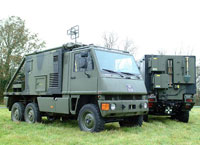|

PERSONAL ROLE RADIO (PRR)
The Personal Role Radio (PRR) is a small
transmitter-receiver that allows infantry soldiers to communicate over
short distances - even through thick cover or the walls of buildings -
without shouting, hand signals or relaying messages.
PRR enables section commanders to react
quickly, aggressively and efficiently to rapidly changing situations
including contact with the enemy - greatly increasing the
effectiveness of infantry fire teams. PRR is issued to every member of
an eight-strong infantry section, and will be available to other
troops in due course.

PTARMIGAN
Ptarmigan is a mobile, secure battlefield
system that incorporates the latest technology and has been designed
to improve communications reliability, capacity and interoperability.
Ptarmigan remains the core equipment for the British Army Tactical
Trunk Communications System, and has undergone a number of upgrades to
be better prepared to meet the challenges of changing deployments and
new operational requirements.
This has included the introduction of an Air Portable Secondary Access
Node (SAN) for 16 Air Assault Brigade. The General Purpose Trunk
Access Port (GPTAP) software enhancement will allow improved
interconnectivity to other nations tactical systems.
Bowman is shortly to replace the HQ infrastructure element of
Ptarmigan. In time, Ptarmigan is due to be replaced by Falcon, which
will not be in service for several years. Falcon is expected to build
on the lessons learned from the current introduction of Cormorant.
Built by Siemens Plessey Christchurch (now part of BAe Systems) in the
mid 1980s, Ptarmigan is a user friendly, computer controlled
communications system which was initially designed to meet the needs
of the British Army in Germany. The system consists of a network of
electronic exchanges or Trunk Switches that are connected by satellite
and multi-channel radio relay (Triffid) links that provide voice,
data, telegraph and fax communications.
The Trunk Switch, radio and satellite relays together with their
support vehicles, comprise a 'Trunk Node' and all field headquarters
include a group of communications vehicles that contain an Access
Switch which can be connected to any Trunk Switch giving access to the
system. This ensures that headquarters have flexibility in both siting
and facilities, and that trunk communications then present no
constraints on operations. Additionally Ptarmigan has a mobile
telephone or Single Channel Radio Access (SCRA) which gives isolated
or mobile users an entry point into the entire system.

TRIFFID
Radio relay links within Ptarmigan are
provided by TRIFFID which is a radio equipment that has three
interchangeable radio frequency modules known as 'heads'. Each TRIFFID
link carries the equivalent of up to 32 voice circuits at a data rate of
512 kb/s plus an engineering circuit.

EUROMUX
EUROMUX is a trunk system manufactured by Racal (now part of the
French Thales group), which is similar in principle to the Ptarmigan
system and is interoperable with the trunk systems of other NATO armies.
TRIFFID is used to provide the relay links within the system.

CORMORANT
|

|
|

|
In service with 2
Signal Regiment, Cormorant will deliver new area communications
capabilities to British Forces and the prime contractor for the
Cormorant programme is the European EADS company.
Cormorant will comprise two primary equipments: a local access
component, based on an ATM switch, which will provide digital
voice subscriber facilities and a high speed data LAN for over 20
Headquarters; and a wide area component will allow the
interconnection of these Headquarters, on a 'backbone'
communications network across a large geographical area as well as
the means to interconnect with single service and multinational
systems.
Designed to link all components of a Joint Force, the system will
enable the force to deploy and operate its Wide Area Network (WAN)
communications system in either peacekeeping roles or in a fully
operational military deployment. The system is fully containerised
and can be operated in either vehicle mounted or dismounted mode.
Each small HQ is designed to scale up in line with the
requirements of a particular operation.
A Cormorant network can consist of the following vehicle-mounted
(or dismounted) installations:
-
Local Area Support module
-
Core Element
-
Bearer Module
-
Long-Range Bearer Module (Tropo)
-
Management Information Systems
-
Interoperable Gateways
-
Tactical Fibre Optic cabling
-
Short Range Radio

FALCON
In March 2006 the
UK MoD signed a contract with BAe Systems Insyte for the first
increment of the Falcon Secure Trunk Communication System.
Falcon will provide a modem, secure communications infrastructure
for deployed formations and operating bases.
As such it will help to deliver an information infrastructure that
will provide the UK Armed Forces with the network enabled
capability required in the 21st century.
The contract is valued at over £200 million and the equipment will
enter into service at the turn of the decade (possibly 2011).

PROMINA
Promina networks
deliver pulse code modulation (PCM) and compressed digital voice
analogue voice, video conferencing, Internet Protocol (IP) frame
relay, asynchronous transfer mode (ATM) and legacy Synchronous and
Asynchronous data services over satellite, microwave, radio and leased
line services.
It is extensively used to multiplex Ptarmigan, ATacCS, and JOCS
systems along side traditional voice, video and fax services over a
common bearer. Promina networks form the core of NATO and Joint Force
HQs, and are deployable for rapid reaction corps.
|